When filling out a Deed form, individuals often overlook critical details that can lead to complications down the road. One common mistake is failing to include the correct legal description of the property. The legal description should precisely identify the property being transferred. Without this information, the Deed may be considered invalid, causing delays or disputes in the future.
Another frequent error is not signing the Deed in the appropriate places. All parties involved in the transaction must sign the document for it to be legally binding. If a signature is missing, the Deed may not hold up in court, which can create significant issues for the new owner.
People also tend to forget to have the Deed notarized. Notarization serves as a safeguard against fraud and ensures that the signatures are legitimate. Without a notary’s acknowledgment, the Deed may be questioned, leading to potential legal challenges later.
Inaccurate information about the parties involved is another mistake that can complicate matters. It is essential to provide full legal names and correct addresses for all individuals or entities involved in the transaction. Omitting or misspelling names can create confusion and may even render the Deed ineffective.
Additionally, individuals sometimes neglect to check for existing liens or encumbrances on the property. If there are outstanding debts or legal claims against the property, these issues must be resolved before the transfer can be completed. Failing to address these matters can result in unexpected liabilities for the new owner.
Lastly, some people do not keep a copy of the completed Deed for their records. Retaining a copy is crucial for future reference, especially if questions arise regarding ownership or the terms of the transfer. Without documentation, proving ownership can become a cumbersome process.
